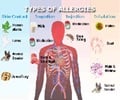A research team has identified a key enzyme responsible for triggering a chain of events that results in allergic reaction, according to new study.
A research team has identified a key enzyme responsible for triggering a chain of events that results in allergic reaction, according to new study findings published online this week in Nature Immunology.
The work by researchers from Virginia Commonwealth University, the Hospital for Special Surgery and Weill Cornell Medical College in New York sets the stage for development of new strategies and target therapies that control allergic disease – the sixth leading cause of chronic disease in the United States.Allergic diseases such as asthma and hay fever are problematic for about 30 percent of the population in the developed world. Researchers have developed various treatments to control allergy, but no cure has been found.
The team has demonstrated, for the first time, the role of a proteolytic enzyme called ADAM10 that releases a major allergy regulatory protein from the surface of cells and thereby promotes a stronger allergic response. The identification of drugs that inhibit ADAM10’s ability to release this molecule could revolutionize treatment of asthma and allergic disease.
“Our research, for the first time, may represent a treatment strategy to prevent, rather than simply control IgE-mediated allergy,” said Daniel Conrad, Ph.D., a professor in VCU’s Department of Microbiology and Immunology. Conrad directed the research conducted at VCU. IgE is an antibody known to trigger Type I allergic disease.
“Understanding ADAM10’s role in allergic disease makes it a potential target for the design of drugs to treat asthma and allergic disease,” he said.
According to Conrad, the outcome of allergic disease can be modulated by high levels of the regulatory protein, known as CD23, which ultimately results in a decreased production of IgE. He said that when the regulatory protein is released from the cell surface by ADAM10 there is an increase in the production of IgE and therefore, increased allergy.
Advertisement
According to Blobel, in addition to the critical role of ADAM10 in allergic disease through processing of CD23, ADAMs are also key molecules in cancer and rheumatoid arthritis. For example, he said, ADAMs are essential for activating the epidermal growth factor receptor, an established target for the treatment of cancers, such as colon cancer. Moreover, ADAMs release tumor necrosis factor alpha, currently the major target for treatment of rheumatoid arthritis.
Advertisement
Source-Newswise
SRM







